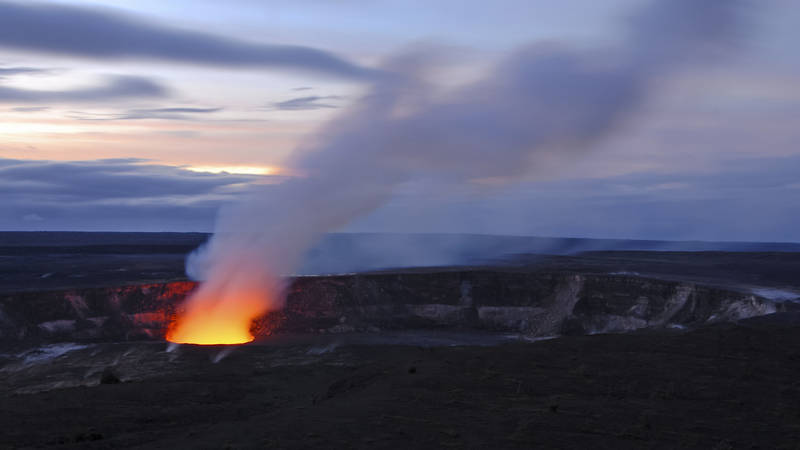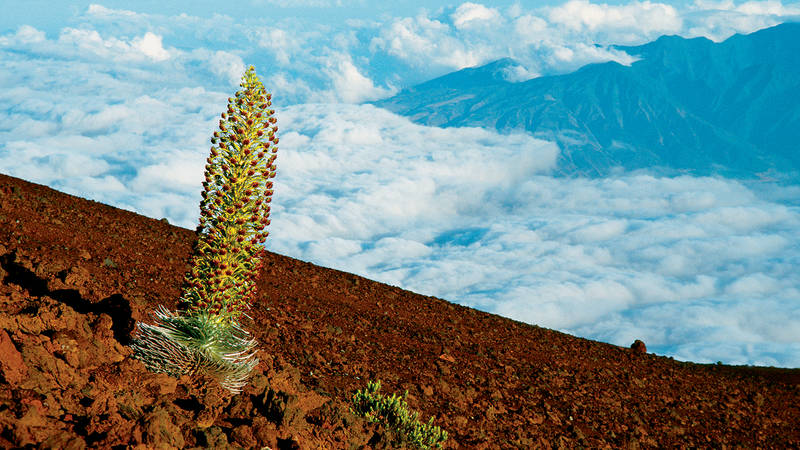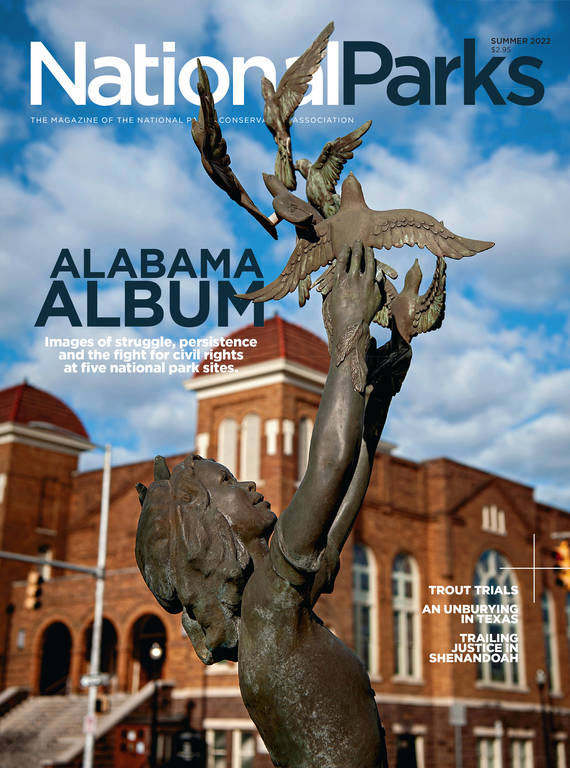Summer 2022
The Enemy Within
For two centuries, feral goats plagued what is now Hawai’i Volcanoes National Park. In the end, controlling them required hunting, fencing and a bit of ungulate espionage.
In April 1981, rangers at Hawai’i Volcanoes National Park took the unprecedented measure of releasing “Agent Orange” into the backcountry.
To be clear, it was not the herbicide once sprayed by U.S. forces during the Vietnam War with devastating consequences for the millions of people exposed to the chemical. This particular Agent Orange, as the park staff called her, was a female goat that had been captured, marked with orange paint and fitted with a radio collar for surveillance by rangers waging a very different kind of battle: the long struggle to eliminate feral goats — highly effective defoliants in their own right — from the park.
The goat problem at Hawai’i Volcanoes traces back to the voyages of English explorer James Cook, who visited the Hawaiian Islands three times beginning in January 1778. The first two times he came ashore, Cook and his crew were warmly welcomed by the Native Hawaiians. The two groups traded goods and exchanged gifts, and Cook introduced goats and the seeds of melons, pumpkins and onions to the islands. The third time, however, was not a charm. Tensions escalated into all-out violence, and Cook perished in the fighting that ensued. Goats, for better or worse, have been around ever since.

Hawai'i Volcanoes National Park
This park preserves the natural setting of two active volcanoes: Kīlauea, one of the most active in the world, and Mauna Loa, one of the largest in the world. Visitors…
See more ›The Hawaiian Islands were home to a unique culture and delicate ecosystem that had long developed in near isolation. Cook and his crew were the first Europeans ever to come ashore there, and their visit took a heavy toll on the islanders and, ultimately, the environment. While the introduction of goats may have been well intended, its impact still can be felt nearly two and a half centuries later.
The island flora was no match for the goats, creatures whose fecundity is nearly as remarkable as their appetite — and that had no natural predators to keep them in check. By the mid-1800s, an expanding goat population was ravaging lowland areas before wreaking havoc on the understory of higher-elevation forests, stripping the bark from the trees, which killed them and thinned out the canopy. Native plant species struggled to survive, nonnative grasses took hold, and bird and insect populations suffered as a result. It was a vicious cycle.
Ranchers and foresters alike viewed the goats as a menace, and large hunting parties were commonplace until the establishment of the park in 1916, when the practice was suspended for more than a decade. According to “Goats in Hawai’i Volcanoes National Park: A Story to be Remembered,” an undated report by park volunteer W. Edwin Bonsey, the territorial government briefly revived eradication efforts within the park, mounting a campaign that eliminated more than 17,000 goats between 1927 and 1931.
That progress was undone in the years that followed, however, as control efforts faltered. In its criticism of the situation, a 1949 piece in the Hawaii Tribune-Herald did not mince words. “Infestations of feral goats and pigs still crawl like vermin over both sections of the park threatening destruction of native forests and plants,” according to the article. “These must be eliminated from the Islands.”
Park managers tried to address the issue, but not without controversy. Beginning in the mid-1940s, Hawai’i Volcanoes hired private companies to conduct goat-shooting drives until the contracts, which flouted National Park Service policy, were halted in 1955; for the next 15 years, park staff conducted hunting drives themselves instead. And Park Service Director George Hartzog Jr.’s subsequent push to include shooters from the public in goat control efforts blurred the lines between managing park resources and permitting sport hunting, an activity otherwise expressly prohibited in the park. The strategy frustrated conservationists but was popular with locals who were happy for the chance to fill their freezers with goat meat. Perhaps too popular ― on its opening day in 1970, the citizen goat-control program attracted so many participants to hunt in a small portion of the park that one of them, a recently returned veteran, said he found it even more dangerous than Vietnam.

Silversword Fight
In Haleakalā National Park, a charismatic plant battles for survival.
See more ›All told, decades of removal efforts had little to no long-term effect on the park’s goat population. From 1955 to 1970, more than 31,000 goats were either killed or captured and removed from Hawai’i Volcanoes. Yet the number of goats in 1970 — about 14,000 — was greater than the number present when the park’s organized control efforts began back in the late 1920s. The goats simply reproduced faster than they could be eliminated; hunting them, on its own, would not be the solution, and in early 1972, the citizen shooting program was dropped.
But good fences make good neighbors, as the saying goes, and that same year park scientists devised a management plan based on the successful recovery of native flora in test plots of parkland enclosed by new goat-proof barriers. By securing one small goat management area at a time, they reasoned, first by fencing and then hunting, they could eventually reclaim all of Hawai’i Volcanoes, all while rebuilding the park’s dilapidated boundary fences to prevent further invasion. “Goats are not part of the natural system,” Robert Barbee, superintendent of Hawai’i Volcanoes, told the Honolulu Star-Bulletin in 1976. “We hope to restore biological integrity to the park.”
That hope was largely realized by the early 1980s when, after a decade of steadfast work by its staff, Hawai’i Volcanoes — at more than 500 square miles, an area comparable with the city of Los Angeles — was free of all but a dozen or so bands of goats. And that’s where Agent Orange came in.
This animal is really betraying its friend.
The remaining goats, having survived previous hunting campaigns, were the wiliest of all, expert at hiding and keenly aware of the presence of humans. Unable to remove what they could not find, the rangers turned to Agent Orange and a dozen other ungulate operatives that followed in her hoof steps. Outfitted with tracking devices, they roamed the park until they found and joined — and thereby revealed the location of — the rogue clusters. Small teams bearing .30-caliber rifles then tracked and eliminated the intruders with the assistance of shooters aboard a helicopter.
“This animal is really betraying its friend,” said Jon Faford, the wildlife biologist at Hawai’i Volcanoes who leads the park’s current monitoring and removal programs and oversees the occasional deployment of double agents, as staff call the infiltrators. “Because they’re such social animals, it wants to find other goats, and so we use the natural behavior of the goats to work in our favor.”

National Parks
You can read this and other stories about history, nature, culture, art, conservation, travel, science and more in National Parks magazine. Your tax-deductible membership donation of $25 or more entitles…
See more ›Today, the goat situation is under control at Hawai’i Volcanoes ― and at Haleakalā National Park, which used the same methods ― but it requires constant vigilance. “We have a total of about 177 miles of boundary and interior fencing,” said Faford, who joined the park staff in 2002, “and that’s basically the core of restoration here in Hawai’i Volcanoes.” A dedicated crew of 10 employees patrols and monitors every last mile of the metal mesh fencing, repairing the damage caused by trees felled by storms and high winds.
It is those breaches that, from time to time, allow feral goats on adjacent property back into the park, but Faford and his team know how to handle the odd interloper. “We’ve literally dealt with thousands of ungulates over the years,” he said, “and when you deal with that many animals, you tend to learn how to think like an animal.”
About the author
-
 Todd Christopher Senior Managing Director, Digital & Editorial Strategy
Todd Christopher Senior Managing Director, Digital & Editorial StrategyTodd guides NPCA's publishing and content strategy and leads the team that produces our website, magazine and podcast. He is also the author of The Green Hour: A Daily Dose of Nature for Happier, Healthier, Smarter Kids.



